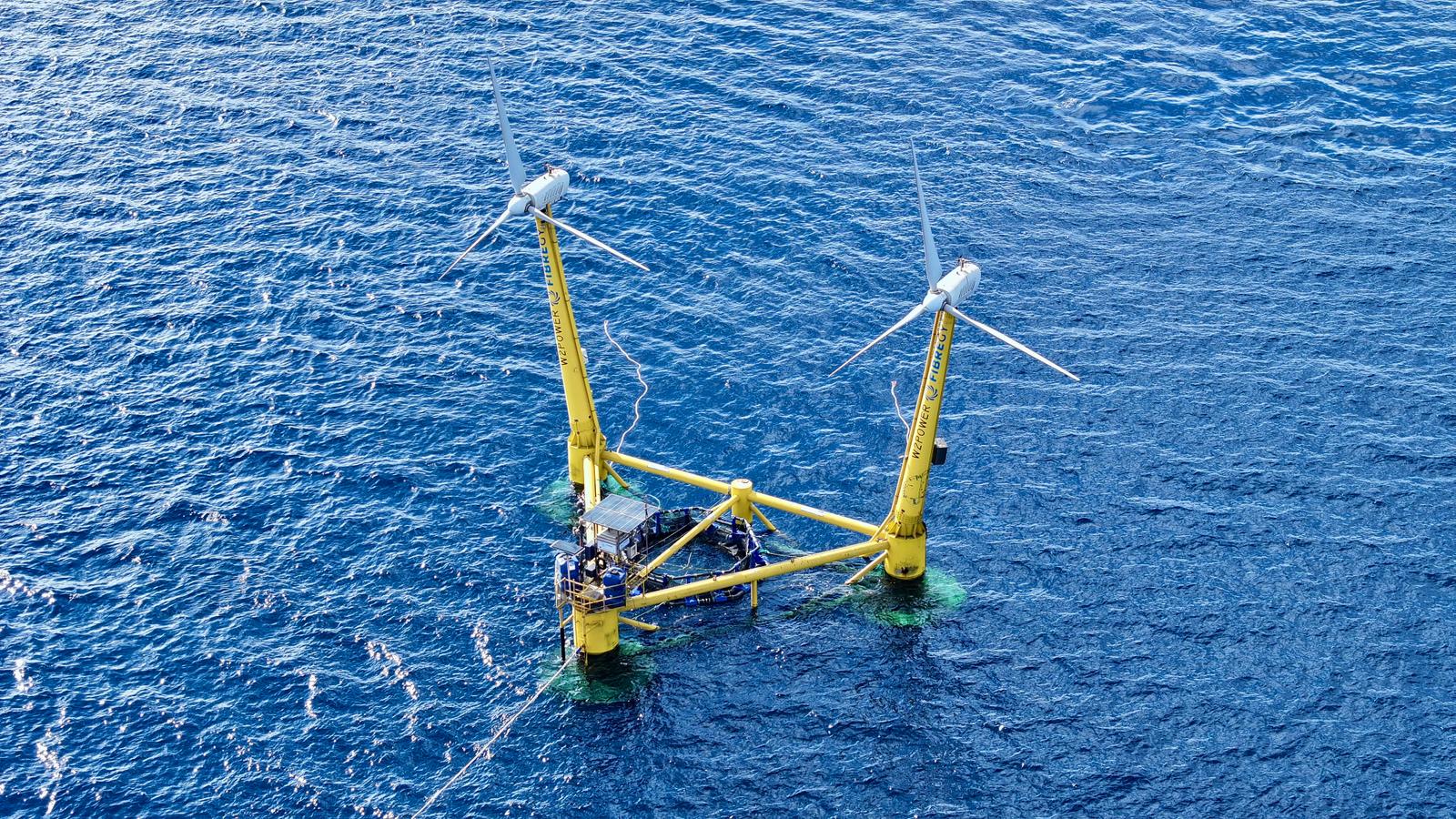The European AquaWind project has reached a major achievement, with its innovative prototype successfully towed and installed at the test site of the Oceanic Platform of the Canary Islands (PLOCAN) on October 18th.
After months of meticulous preparation and testing at the Astican facilities in Las Palmas de Gran Canaria’s Port, the device was towed and installed offshore to begin its crucial testing phase under real-sea conditions, in an operation coordinated by EnerOcean with the support of Capitanía Marítima de Las Palmas, Astican, Boluda, Miller, and Trames
Dual Innovation
This prototype represents a pioneering step, combining two key innovations within a single infrastructure: the W2Power twin-turbine floating wind platform, developed by the Spanish company EnerOcean and an advanced aquaculture cage designed by the GOBCAN_ACIISI/ULPGC team.
The cage incorporates next-generation net materials and digitalised remote-control systems. It is specifically equipped for biological studies using various fish species, including one of high added value that will contribute to diversifying aquaculture practices.
The multi-use concept behind AquaWind is aimed at addressing a core European Union challenge: optimising the sustainable and efficient use of marine space. By successfully integrating renewable energy and aquaculture in one location, the project significantly reduces its carbon footprint, aligning directly with the EU’s climate and energy objectives.
Crucially, this is the first time in the Atlantic that trials combining marine renewable energy production with live fish farming have been carried out in the same maritime area. The tests will study the interactions between both activities and how they can be jointly managed through remote-control systems. The clear goal is to demonstrate that this multi-use solution is not only viable but also replicable and scalable, paving the way for its future commercialisation.
Rigorous Land-Based Preparation
Before its offshore deployment, the prototype underwent rigorous testing at Las Palmas de Gran Canaria Harbour, where the ENEROCEAN team retrofitted the W2Power Prototype, which was being theoretical modelized with INNOSEA team, including the Aquaculture systems integration. At the same time, WAVEC supported by the PLOCAN team, conducted first environmental campaign to evaluate sediment composition, water quality and underwater noise in collaboration with ULPGC and CANEXMAR.
In Parallel, at the Taliarte harbour test site, researchers from GOBCAN-ACIISI and ULPGC, supported by the CANEXMAR team, spent several months refining the remote operation systems of the prototype fish cage. They also conducted two comparative trials using gilthead seabream (Sparus aurata) as a model species assessing the biological performance of fish reared in the AquaWind system with those grown in conventional aquaculture cages at the CANEXMA R farm.
The harbour trials provided valuable reference data on growth and survival performance, general health, and biochemical indicators of the fish. These studies allowed the team to established baseline parameters for stress biomarkers in blood and scales.
This preparatory work was essential for validating AquaWind’s aquaculture innovation.
Next Steps and Future Scope
Over the coming months, the AquaWind team will assess fish growth, survival, and quality in offshore conditions, as well as the environmental impact and system durability. Following this initial phase with gilthead seabream, preliminary trials with greater amberjack (Seriola dumerilii) will be conducted to further evaluate the system’s performance with other high-value species.
The data gathered will be key to optimising the prototype and establishing the foundation for future pre-commercial and commercial implementations. This includes the potential expansion of pilot systems across the Atlantic, improved digitalisation, the development of a scalable business model, and the strengthening of international collaboration to advance sustainable aquaculture and integrated marine energy.
The AquaWind project is co-funded by the European Union under Grant Agreement No. 101077600. Key consortium partners include ACIISI, ULPGC, EnerOcean, CANEXMAR, PLOCAN, Consulta Europa, the Canary Islands Maritime Cluster, WAVEC, and INNOSEA.

